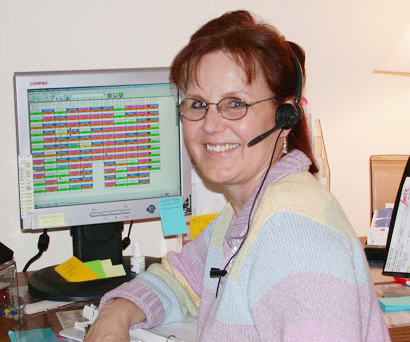Packard’s
new ‘bed board’ program boosts efficiency
Broad effort under way to improve admitting,
discharge
By KRISTA CONGER
Bonnie Kintner enjoys her job. “I just
love showing this off to people,” the registered nurse said.
“It’s so much fun.” As she speaks, she gazes at a
brightly colored, complex grid on her computer monitor. Boxes of
blue, pink, white and green – one for each room in the
hospital – dance with colored dots and status messages on
Lucile Packard Children’s Hospital’s newly instituted
bed board: filled or empty, clean or dirty, assigned or
up-for-grabs.
For eight hours a day, Kintner shepherds each bed through
occupancy, unassigned vacancy, cleaning and re-occupancy.
Kintner’s goal to eliminate any needlessly empty room marks
ongoing efforts at the hospital to increase the efficiency of bed
space usage without compromising patient care. Increasing numbers
of patients coupled with a static number of beds in the hospital
have forced staff to streamline the discharge and bed-turnaround
processes while also adding beds off-site. So far the efforts seem
to be working.

Bonnie
Kintner’s smile gets even bigger when she looks at her
computer screen these days. A computerized “bed board”
planning system now in place at Packard Children’s Hospital
enables doctors, nurses and housekeeping staff to minimize the
length of time a bed stays empty. Photo: Krista Conger
“The week of Jan. 16, Packard had the highest occupancy rate
we’ve ever seen,” said Susan Flanagan, chief operating
officer. “Occupancy has increased from 80 percent at this
time last year to about 88 percent today.” In human terms,
that means caring for an additional 20 children each month and
significantly reducing the number of kids the hospital must turn
away due to lack of space.
Kintner and the bed board are only one of the many changes afoot.
Others include encouraging physicians to write discharge orders by
10 a.m. and striving to identify those patients likely to be
discharged the following day.
“We have retooled our discharge process to focus on one
question: What are the key things that need to happen for a patient
and family to be prepared for discharge?” said Flanagan.
“In the past, decisions about patient education, coordinating
with parents and interpreting for the family were often made after
the discharge order was written,” she added. “We were
reacting to the situation, and we needed to be more
proactive.”
Now patients’ families and hospital staff can work together
in advance to arrange transportation from the hospital, obtain
needed medications from the pharmacy and discuss how to care for
the patient at home. The current average discharge time has shifted
from 4:30 p.m. to 2:45 p.m. each day.
“Improving discharge times is important to make sure there
are beds available in the early afternoon for emergency patients
and children recovering from surgery. If beds aren’t
available until six or seven in the evening, we can’t serve
these patients as well as we can if we have beds at eleven in the
morning,” said hospital chief of staff Harvey Cohen, MD,
PhD.
Room cleaning after discharge has also come under scrutiny. All
housekeepers now have beepers and are automatically paged as soon
as a discharge order is entered into the computer. The housekeepers
report when they start and finish each room, allowing Kintner to
track their progress on the bed board and assign beds as soon as
they are available.
“This multidisciplinary approach to alleviating the bed
crunch has resulted in an increased ability to care for more
children,” said Cohen, professor of pediatrics. “Now we
don’t have to turn away as many kids who need our help.
We’re also doing a better job of taking care of the needs of
our community doctors.”
Finally, the addition of eight new Packard Children’s
Hospital beds at El Camino Hospital in Mountain View last month has
eased some pressure. The beds are earmarked for low-acuity general
pediatric, pulmonology, pain and rheumatology patients. Kintner
works closely with the admitting physicians to determine which
patients are appropriate for the new site. An additional eight beds
at El Camino Hospital are planned to open this spring.
“It’s important to think about where kids can best be
cared for,” said Cohen. “Now that we are seeing
patients there, we are able to open up beds on the general
pediatric unit here.”
Weekly patient progression meetings are attended by nursing
leaders, case managers, physicians and the housekeeping staff to
ensure that the changes continue to improve discharge coordination
and utilization of beds. “We measure our results against our
goal and discuss areas that can be improved,” said
Flanagan.
“The physicians are happy because they can see the results of
this. They can see that we are able to admit more patients and that
that we no longer routinely have patients waiting in line for
beds,” said Flanagan. “The support of the housekeepers
has also been tremendous. When they heard that we are now able to
serve about 200 more patients per year, the pride on their faces
was worth a thousand pictures.”
Kintner has also heard lots of positive feedback.
“We’re striving for more efficient patient care, and it
seems to be working really well,” she said. “I spent
four months as an area case manager before taking this job, and
this system is like an answer to my prayers.”

|

